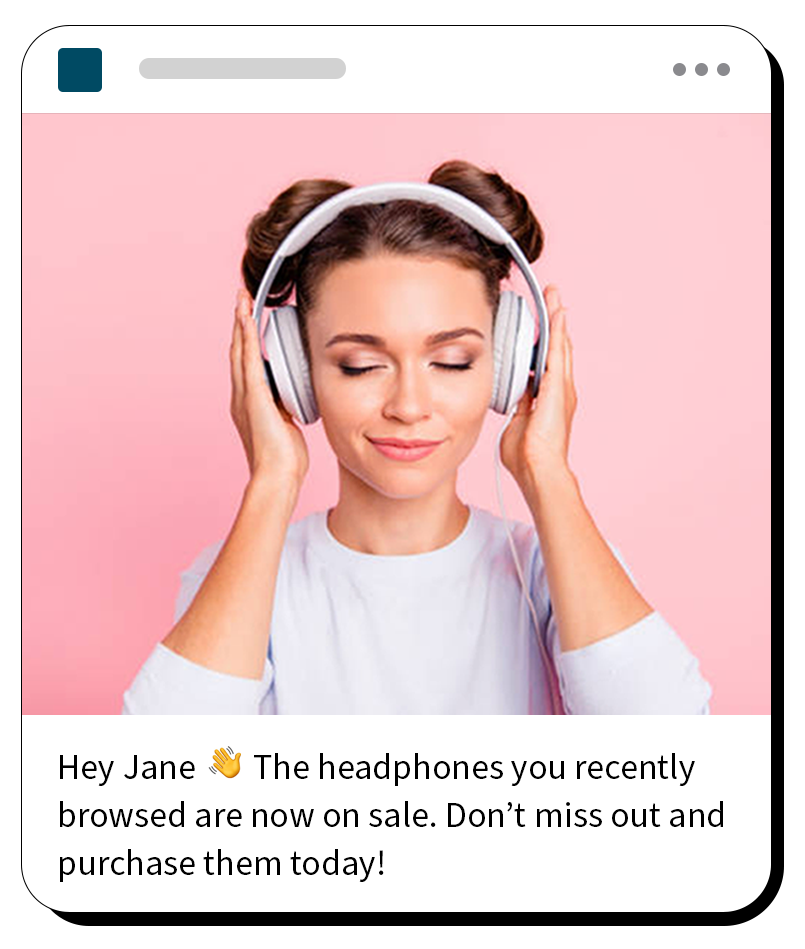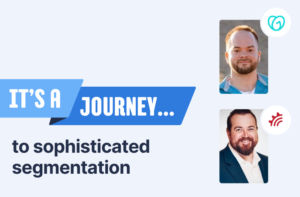Today’s marketers know that it’s rare to capture a customer’s attention and loyalty with just a single brand interaction. Building trust and meaningful connections with your audience takes time and multiple thoughtful touchpoints. Fortunately, a lifecycle marketing strategy can help brands attract and retain customers beyond the initial purchase.
In this article, we’ll delve into what lifecycle marketing is, explore some real-world examples, and provide best practices for cultivating lasting customer relationships at every stage of their journey.
What is customer lifecycle marketing?
Lifecycle marketing is the mix of strategies a company uses to positively influence customer behavior as they move through each stage of the marketing cycle, from the initial interaction to becoming a long-term returning customer.
Every business has its own unique lifecycle marketing strategy, but the purpose is the same: to engage customers, increase customer lifetime value (CLV), and drive brand loyalty.
Unlike the buyer’s journey or conversion funnel, lifecycle marketing considers a customer long after they make a purchase. The focus is to bring in buyers and turn them into loyal brand advocates who return again and again.
The benefits of customer lifecycle campaigns
For customer-centric brands, lifecycle marketing offers a holistic approach to customer acquisition, engagement, and long-term retention.
Increased customer retention
We all know the math: retaining customers costs less than acquiring new ones. Customer lifecycle campaigns are like a safety net for your customer base. They prevent them from slipping away by consistently engaging with them throughout their journey with your brand.
By maintaining a strong connection with your existing customer base and providing them with ongoing value, you increase the likelihood they’ll continue choosing your brand over others. This results in lower customer churn, safeguarding the customer relationships you’ve worked hard to establish.
Higher customer lifetime value
Lifecycle campaigns help maximize CLV by nurturing customer relationships and encouraging repeat purchases.
For example, a coffee chain might welcome new app users with a personalized email thanking them for joining along with 50% off their first drink. After a customer’s first purchase, they receive a follow-up email inviting them to a loyalty program that offers a free coffee after every ten purchases.
As the customer regularly visits, the coffee chain gathers data about their individual preferences and behavior. Rather than generic promotions, the customer receives personalized offers related to their favorite items.
This level of personalized engagement deepens the customer’s connection with the brand and significantly contributes to an increased CLV over time.
Customer satisfaction and brand loyalty
Lifecycle campaigns play a pivotal role in enhancing customer satisfaction and fostering brand loyalty. An effective lifecycle strategy engages customers at every stage of their brand journey, creating a meaningful and ongoing connection.
Whether it’s a special offer on a customer’s birthday or helpful post-purchase content, continuous interaction sends a clear message: your brand values its customers and is committed to meeting their individual needs.
When customers can resonate with your brand on a personal level, they are more likely to remain loyal, not just as customers but as passionate brand advocates.
Stages of the customer lifecycle
As mentioned, the customer lifecycle outlines the path a consumer makes from their first interaction with your company to well after becoming a loyal customer. It occurs over five key stages, and each requires a different marketing approach.
Understanding these stages is crucial to tailoring your interactions, reducing churn, nurturing loyalty, and optimizing the customer journey.
 Stages of customer lifecycle marketing
Stages of customer lifecycle marketing
1. Awareness
The awareness stage is where potential customers first learn about your brand. As the top of your conversion funnel, it’s your chance to capture people’s attention and reel them further into your funnel. Often, customers learn about a new brand through lead sources like social media, organic search, website content, paid advertising, etc.
2. Engagement
At the engagement stage, people start interacting with your brand. They’re interested and want to learn more about your offerings. This could be through scrolling your website, subscribing to your email list, or following you on social media. These prospects are still pretty new to your brand, so you’ll want to share information about your offerings and answer their questions with thoughtful content.
During this phase, you start to capture valuable audience data and gain insights into preferences and behavior. With this first-party data in hand, you can segment your audiences and begin nurturing the relationship through personalized communications tailored to their preferences and actions across your brand channels.
3. Purchase
Here’s where a customer decides to buy your product or service. Although they’ve reached the point of making a purchase, things can still go wrong, and sales can fall through at the 11th hour. So, your job as a marketer is to make that process as seamless as possible.
4. Loyalty
Loyalty is the ultimate payoff of customer lifecycle marketing. After the first purchase, your focus moves to nurturing an ongoing relationship to encourage repeat business.
Relevant content, personalized offers, loyalty programs, and customer feedback all come into play at this crucial stage.
For example, you might send a post–purchase push notification recommending complementary items or deals on items they’ve purchased before. You can also encourage loyalty with rich and dynamic emails featuring referral bonuses for loyal customers to spread the word about your product.
If you can successfully guide a customer through each previous stage, you will likely come out the other side with a customer who is a strong brand ambassador.
B2C lifecycle marketing campaigns
In a B2C environment, you are marketing the product directly to the customer. Thus, it’s the individual customer who is interacting with the business. This is a crucial difference, as customers tend to make decisions based far more on emotion than logic. Thus, B2C strategies focus less on logic and instead pull on the emotional responses of their target market.
There is a wealth of possibilities for the type of customer journeys that can be dreamt up with the right tools. Here are just a few of the major lifecycle campaign types:
New customer campaign
Set new customers on a path toward brand advocacy with welcome emails, requests to update their profile, or start introducing them to new product launches.

Winback campaign
Win back lapsed customers who haven’t interacted with your brand in a set period of time with custom messaging campaigns to re-establish their interest. People are busy these days, attention spans are shrinking, and it’s easy to get lost in the shuffle. The passion with which a consumer is researching your product today can fade to a distant memory in a matter of hours. But that doesn’t mean they’ve sworn you off entirely.

With re-engagement campaigns, you can lure your customers back to you. Past behavior is the best predictor of future behavior. If they bought from you once and were satisfied, there’s a good chance you have an opening to bring them back. Entice them! Reminding a subscriber you haven’t heard from in a while why they fell in love with you in the first place could rekindle that fire. You have nothing to lose from starting a thoughtful winback campaign for re-engaging lapsed customers and plenty to potentially gain.
Abandoned cart campaign
Often, customers show interest in an item but then never complete a purchase. Who knows why they abandoned that cart or browsing session? Maybe they had an emergency, the kids wanted their lunch, or the prospect just got distracted.

It’s also worth considering they could have had a problem with the website. Sending an email reminding the prospect they didn’t complete their purchase could help close the sale. Group these customers, test, optimize, and measure the success of your messaging.
App download campaign
Take advantage of SMS notifications to remind your customers of your branded app, taking users straight to their App Store for an easy download.

A cross-channel approach to customer lifecycle marketing
Engaging customers across multiple channels has more bottom-line value than you might realize. Research from Omnisend shows that customers who interact with three or more channels spend 13% more ($66.31) than those who engage with just one channel ($58.70).
To make the most of this, create a cohesive strategy that combines email with mobile push, in-app messaging, and SMS. Tailor your messaging for each stage of the customer journey based on individual preferences and behavior. Remember, you can’t market to every consumer the same way; their attitudes and emotions change. So, continue collecting user data to help you accurately personalize at every customer touchpoint.
Launch lifecycle marketing campaigns with MessageGears
When it comes to customer lifecycle marketing, MessageGears clients have a number of advantages due to the unique structural setup of MessageGears’ customer engagement platform. Because it operates in a fundamentally different way than the legacy cloud providers’ platforms that most marketers are used to, it’s able to empower marketing and data teams in a new way to help them engage customers throughout the journey. Some of the main benefits include:
Real-time data access
Because we connect directly to our client’s database, they don’t have to copy and ship their data to an external cloud environment anymore to build audiences for executing campaigns. This means they have real-time access to the data, don’t have to wait for frustrating data syncs to complete, have vastly improved data security, and save money from not having to store the same data twice.
Data security
MessageGears customers benefit from using a platform that enables high levels of security for their customer data. Because MessageGears is warehouse-native and integrates within a brand’s modern data warehouse environment, customer data never leaves a brand’s firewalls and remains secure – eliminating worries of a data breach.
Message scalability
From direct connection to big swaths of data to bulk message processing and the ability to separate bulk job processing from critical render and delivery services, MessageGears’ scaling capabilities are best in class.
Campaign speed and flexibility
Having complete access to all their data for building campaigns means better personalization because marketers can quickly utilize any data point for personalization without having to wait for data syncs. When creating customer lifecycle campaigns, that sort of flexibility and speed is crucial to getting the campaign out the door. Timing can often make the difference between being ignored and an important conversion.







